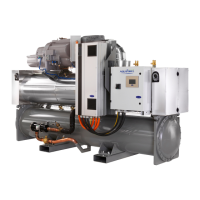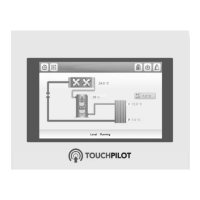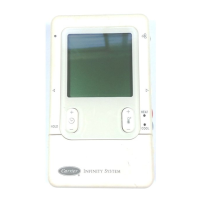3
1.1 - General
Installation, start-up and servicing of equipment can be
hazardous if certain factors particular to the installation are
not considered: operating pressures, presence of electrical
components and voltages and the installation site (elevated
plinths and built-up structures). Only properly qualied
installation engineers and highly qualied installers and
technicians, fully trained for the product, are authorised to
install and start up the equipment safely. During all servicing
operations all instructions and recommendations which
appear in the installation and service instructions for the
product, as well as on tags and labels xed to the equipment
and components and accompanying parts supplied sepa-
rately, must be read, understood and followed.
• Apply all standard safety codes and practices.
• Wear safety glasses and gloves.
• Use the proper tools to move heavy objects. Move units
carefully and set them down gently.
IMPORTANT: Some specic safety precautions should be
taken in case of HFO units. For more information about
handling the equipment safely, please refer to the IOM Unit
documentation (Installation, Operation and Maintenance
instructions).
1.2 - Avoid electrocution
Only personnel qualied in accordance with IEC (Inter-
national Electrotechnical Commission) recommendations
may be permitted access to electrical components. It is
particularly recommended that all sources of electricity to
the unit be shut off before any work is begun. Shut off the
main power supply at the main circuit breaker or isolator.
IMPORTANT: This equipment uses and emits electro-
magnetic signals. Tests have shown that the equipment
conforms to all applicable codes with respect to electro-
magnetic compatibility.
RISK OF ELECTROCUTION: Even when the main circuit
breaker or isolator is switched off, certain circuits may still
be energised, since they may be connected to a separate
power source.
RISK OF BURNS: Electrical currents cause components
to get hot either temporarily or permanently. Handle power
cable, electrical cables and conduits, terminal box covers
and motor frames with great care.
2.1 - General
Touch Pilot is a system for controlling 30XW-V/30XWHV
single-circuit or dual-circuit water-cooled units with R-134a
refrigerant as well as 30XW-V-ZE single-circuit or dual-circuit
water-cooled chillers with R-1234ze refrigerant (HFO).
Touch Pilot controls the start-up of the compressors needed
to maintain the desired heat exchanger entering or leaving water
temperature. Touch Pilot constantly monitors safety devices
to ensure unit protection. Touch Pilot also gives access to a
Quick Test program covering all inputs and outputs.
All Touch Pilot controls can work in accordance with three
independent modes:
• Local mode: the machine is controlled by commands
from the user interface.
• Remote mode: the machine is controlled by volt-free
contacts.
• Network mode: the machine is controlled by commands
from the Carrier Comfort Network (CCN) or the
BACnet/IP network (option). A data communication
cable is used to connect the unit to the CCN communica-
tion bus. To connect the unit to the BACnet network,
an Ethernet cable is used.
The operating mode must be chosen with the Start/Stop
button described in chapter 4. When the Touch Pilot system
operates autonomously (Local or Remote mode) it retains
all of its own control capabilities but does not offer any of the
functions of the CCN or the BACnet/IP network, except the
“CCN emergency stop” command (if this command is active,
it stops the unit whatever the active operating type).
2.2 - Abbreviations used
In this manual, the refrigeration circuits are called circuit A
and circuit B.
The following abbreviations are used frequently:
Operating type: Local O
2. Local-On Operating type: Local On mode
3. Local-Schedule Operating type: Local On following a time schedule
4. Network mode CCN or BACnet/IP operating type
5. Remote mode Operating type: by remote contacts
6. Master mode Operating type: master unit (master/slave assembly)
7. CCN Carrier Comfort Network. This is the Carrier communication
network
Light-emitting diode
9. SCT Saturated condensing temperature
Internal communication bus linking the basic board to the
slave boards
11. SST Saturated suction temperature
12. OAT Oudoor Air Temperature
13. BACnet Building Automation and Controls network: open communica-
tion network, compatible with most control/monitoring/
interoperability functions
Variable Frequency Drive

